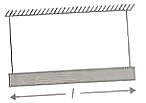A solid cylinder of mass M and radius R rolls down an inclined plane of height h without slipping. The speed of its centre of mass when it reaches the bottom is
(1)
(2)
(3)
(4)
A ball is travelling with uniform translatory motion. This means that:
1. It is at rest.
2. The path can be a straight line or circular and the ball travels with uniform speed.
3. All parts of the ball have the same velocity (magnitude and direction) and the velocity is constant.
4. The centre of the ball moves with constant velocity and the ball spins about its centre uniformly.
A metre scale is moving with uniform velocity. This implies:
1. The force acting on the scale is zero, but a torque about the centre of mass can act on the scale.
2. The force acting on the scale is zero and the torque acting about centre of mass of the scale is also zero.
3. The total force acting on it need not be zero but the torque on it is zero.
4. Neither the force nor the torque need to be zero.
When a mass is rotating in a plane about a fixed point, its angular momentum is directed along
1. a line perpendicular to the plane of rotation.
2. the line making an angle of 45o to the plane of rotation.
3. the radius.
4. the tangent to the orbit.
A pulley is hinged at the centre and a massless thread is wrapped around it. The thread is pulled with a constant force F starting from rest. As the time increases:
1. Its angular velocity increases, but force on hinge remains constant
2. Its angular velocity remains same, but force on hinge increases
3. Its angular velocity increases and force on hinge increases
4. Its angular velocity remains same and force on hinge is constant.
For which of the following does the centre of mass lie outside the body?
1. A pencil
2. A shotput
3. A dice
4. A bangle
When a body is rolling without slipping on a rough horizontal surface, the work done by friction is
(1) Always zero
(2) May be zero
(3) Always positive
(4) Always negative
A disc of mass m and radius r is free to rotate about its centre as shown in the figure. A string is wrapped over its rim and a block of mass m is attached to the free end of the string. The system is released from rest. The speed of the block as it descends through a height h, is

(1)
(2)
(3)
(4)
Two like parallel forces 20 N and 30 N act at the ends A and B of a rod 1.5 m long. The resultant of the forces will act at the point
(1) 90 cm from A
(2) 75 cm from B
(3) 20 cm from B
(4) 85 cm from A
A uniform rod of mass m and length l is suspended by two strings at its ends as shown. When one of the strings is cut, the rod starts falling with an initial angular acceleration

(1)
(2)
(3)
(4)






